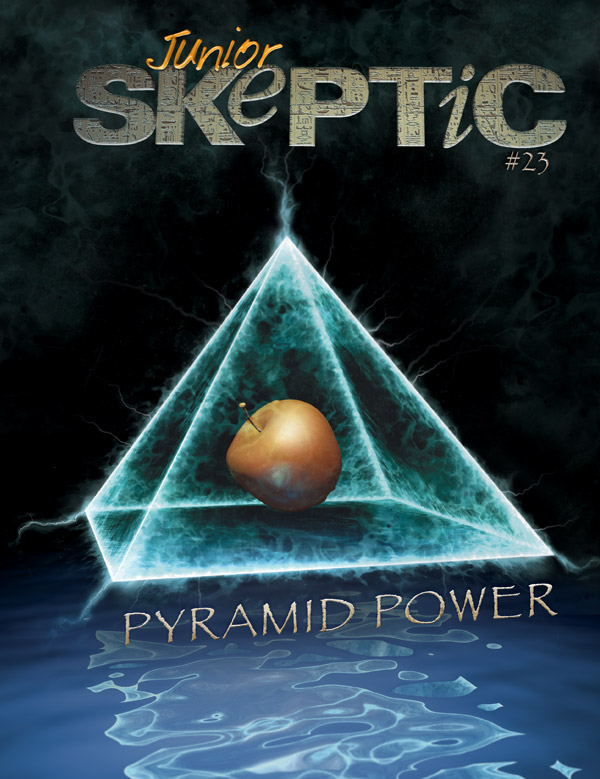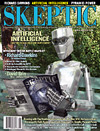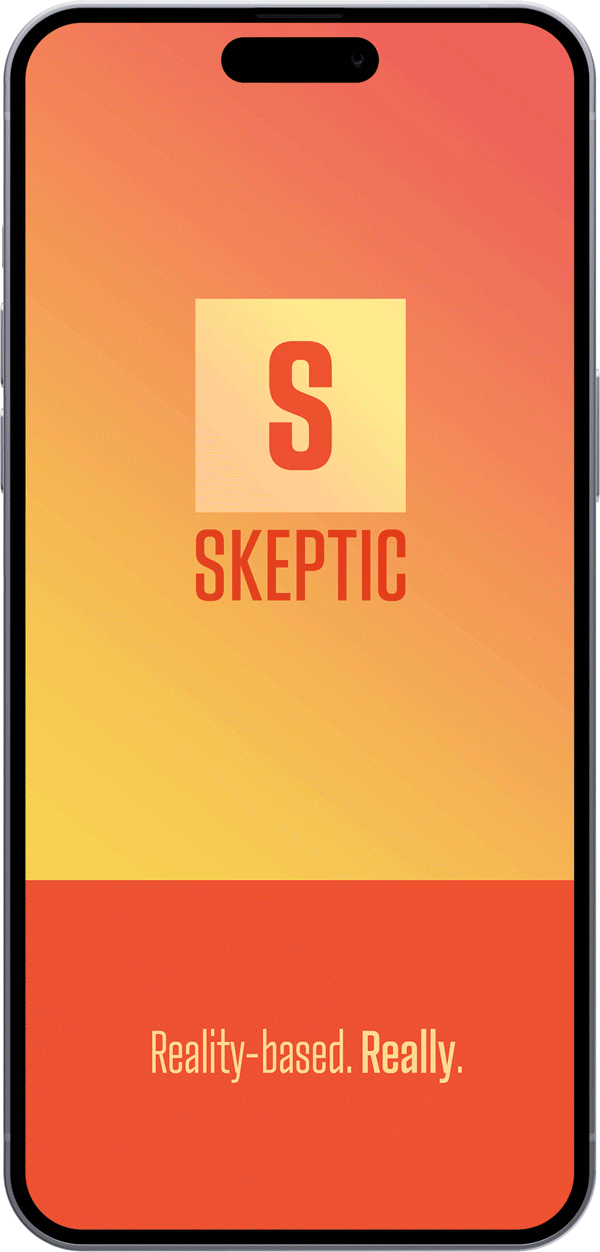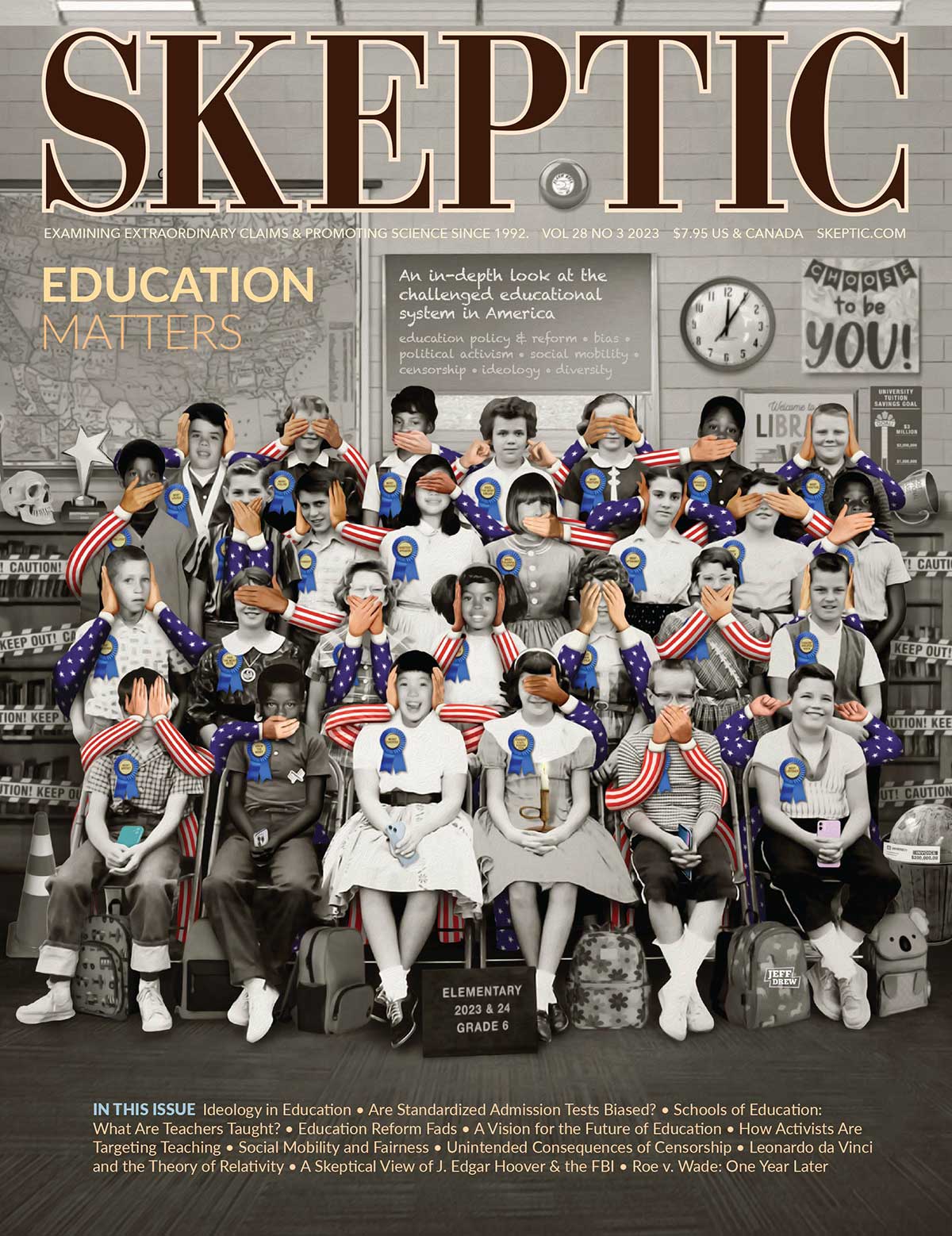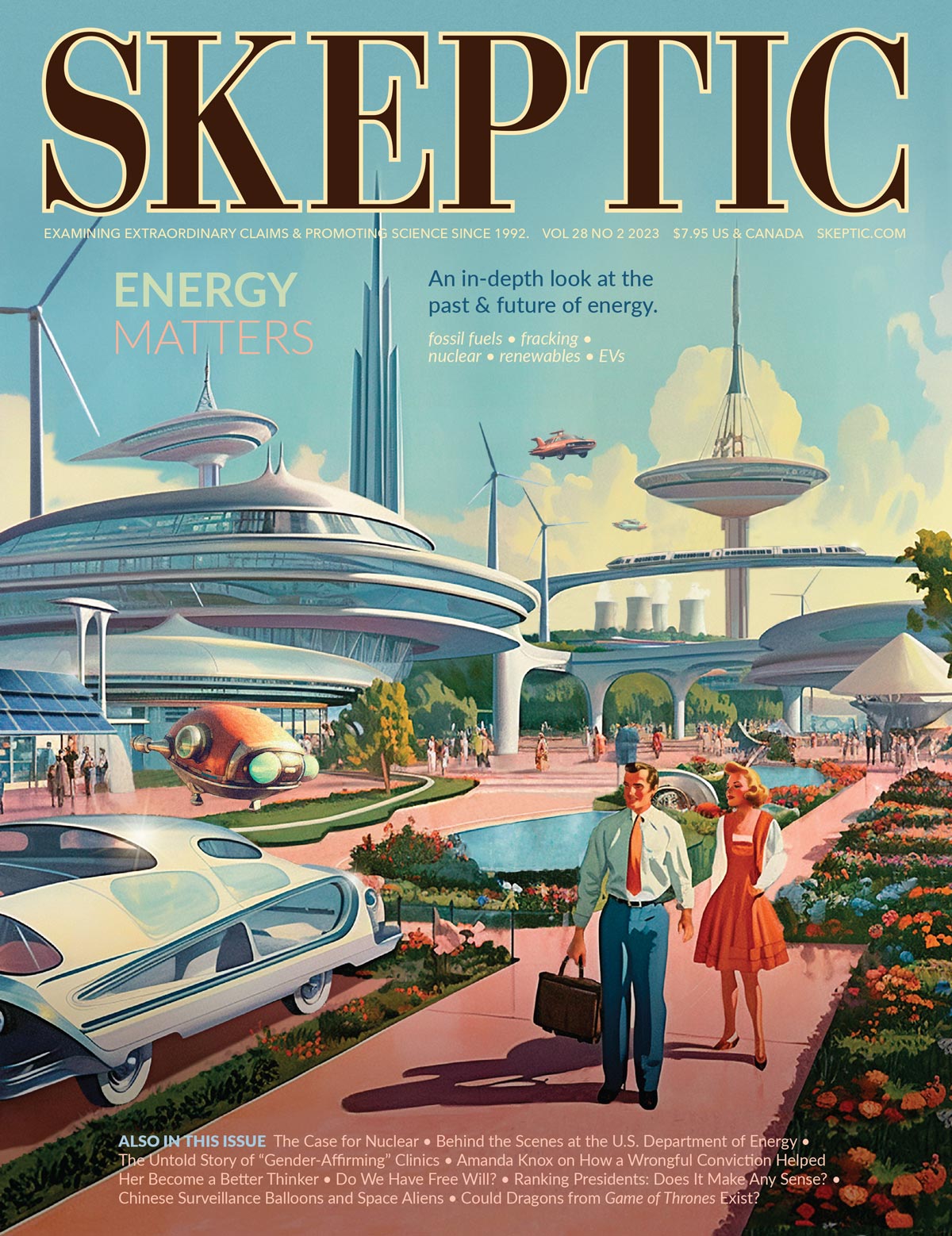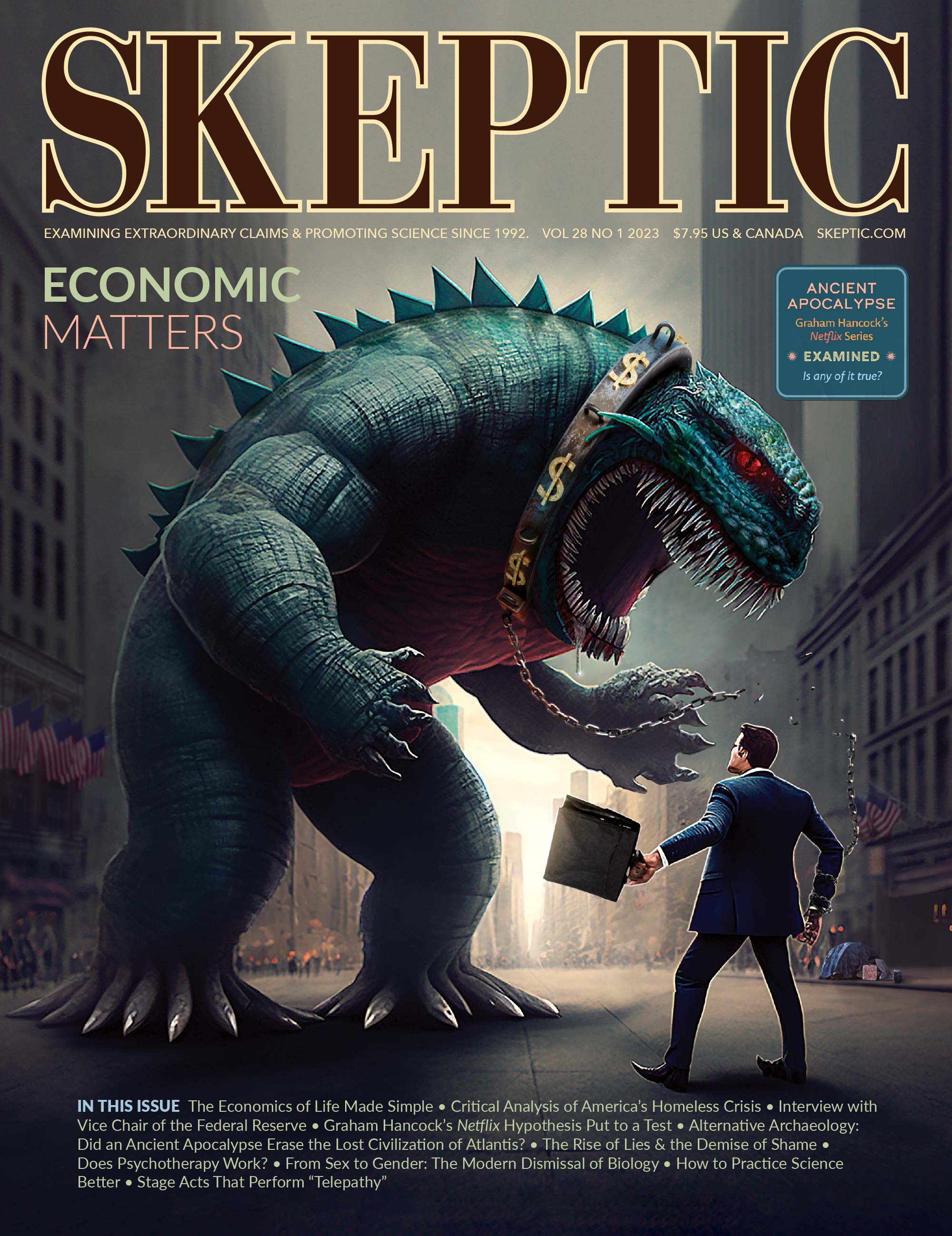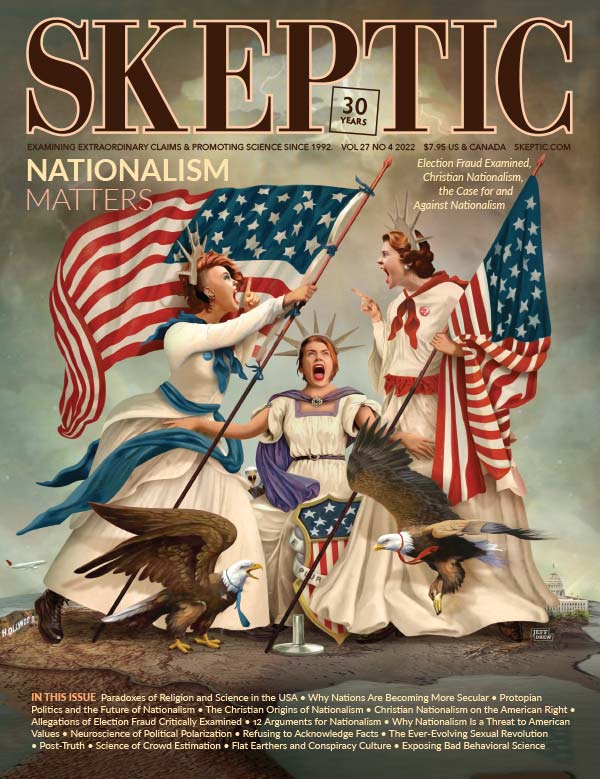When researching for Junior Skeptic #23: “Pyramid Power”, I conducted a lengthy fact-finding interview with author Max Toth, whose 1970s book Pyramid Power propelled this paranormal concept to pop culture fad status. Toth turned out to be a genial and generous source regarding the history and business of pyramid power.
One of the primary activities of organized skeptics is to function as historians of paranormal claims. In this role, paranormal proponents are crucially important partners and allies to skeptical investigators. (I am reminded of Harry Houdini's friendly conversations with “spirit medium” pioneer Ira Davenport. Davenport was a source of historical information that was simply not available anywhere else — the secrets of the Davenport Brothers mediumship act — and he was generous enough to share that unique knowledge with Houdini.)
Toth was happy to reminisce about his role in generating a pop phenomenon, and we're pleased to present most of that rambling conversation here. Readers are cautioned that this transcript is edited only very lightly, and offered as essentially raw historical data. I found it very useful.
Interview with Max Toth
conducted December 2005
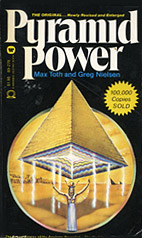
a paranormal hit of the 1970s
- Skeptic
- The first question would be: How do you correctly pronounce Karel Drbal’s name?1
- Toth:
- “Karl Dra-BAHL.”
- Skeptic:
- That’s useful. I was wondering if you could tell me a little bit more about the arrangement for the rights back in the day.2
- Toth:
- When I met Karel Drbal, he was very outgoing and showed me all of his experiment and all of his notations, and he explained to me that just before World War II and through most of World War II, he was selling these little styrene plastic pyramids that would sharpen Gillette blue-blades, because the Gillette blue-blades were a treasured item in East Europe. It was hard to come by. So, in his experimental stage, he found that you can keep the Gillette blue-blades sharp. It’s not sharpening them — it’s keeping them sharp.
- Skeptic:
- Right.
- Toth:
- I don’t know how many he actually sold, but I had the impression that he had sold thousands of them throughout East Europe and Germany. He obviously didn’t speak English, but he spoke a little bit of German, and I speak a little bit of German, and I had a friend of mine who knew a little bit of English, and with that—
- Skeptic:
- Is this Zdenek?3
- Toth:
- Zdenek Rejdak.
- Skeptic:
- Okay.
- Toth:
-
He told me that, at his age, he was more interested in getting this information about the pyramid energy out to the rest of the world, and he thought that I might be able to be the vehicle with which to do it. So, he gave me some of his documentation, and he gave me his only styrene plastic pyramid that he had left.
When World War II was over, the Russians confiscated everything, and obviously he lost his patent rights, etc. So he — on a handshake — he says, “I’ll let you market and build whatever pyramid structure you want in America. Just get the word out.”
And I said, “Fine.” I came back to the States and I was very, very skeptical about everything I had seen and heard. I started doing experiments myself at home, building cardboard pyramids to the specifications of his styrene plastic pyramid. And I found that the darn thing does work. I had to make sure that the pyramids were aligned correctly to true north, as opposed to magnetic north and give sufficient time for the energy in the pyramid to work. When I saw that this was the case, I was including my visit to him and learning about pyramid energy in the lectures on psychic energy which I had started.
- Skeptic:
- Right.
- Toth:
- Based on the book that was very popular in the late sixties and early seventies, written by two ladies, and titled Psychic Discoveries Behind the Iron Curtain, I basically designed my trip to East Europe.
- Skeptic:
- Okay.
- Toth:
- At one of my lectures, an editor from Esquire magazine had given me his card, and he said, “Let’s do lunch.” And I said, “Fine.” Within a couple of days, we had lunch, and he picked my brain, so to speak, and he said, “I’m going to write an article on this pyramid energy.” That’s when I coined the term “Pyramid Power,” because “Flower Power” was the term in the early seventies. So I thought, “Well, there’s Flower Power. Why not Pyramid Power?”
- Skeptic:
- And you coined “Pyramid Power” and not Patrick Flanagan?
- Toth:
-
Yeah. Flanagan and I are — have been — rivals back and forth. He claims he coined it and tried to sue me when my book4 came out called Pyramid Power, because he had written a book called Pyramid Power.5
I was completely out of the loop, because the lawsuit had to go between the publishers and not between the authors. It turns out that titles of books cannot be copyrighted. Titles of books become public domain, so you can have more than one book with the same title.
- Skeptic:
- I see.
- Toth:
- Anyway, Esquire magazine came out with a two-page spread on “Pyramid Power.” And the author also included Pat Flanagan in the article, which I think was very nice because Pat was working based on just the book alone called Psychic Discoveries Behind the Iron Curtain.
- Skeptic:
- Right.
- Toth:
- And he started doing experimentations with “pyramid energy plates.” To this day, he has never really explained to me how he was energizing these purple, painted plates that he was selling as being “pyramid-energized.”
- Skeptic:
- [Laughs]
- Toth:
-
Anyway, the producers of the Mike Douglas Show got in touch with me through Esquire magazine and wanted me on their show. So, I went down to Philadelphia about a year later and appeared on the show. I showed my pyramid models and talked about the preservative properties of the pyramid.
Then, within a couple of days of appearing on the show, a publisher called me up and wanted me to write a book on “Pyramid Power.” I told the publisher, “Very nice offer, but I don’t know how to write.”
- Skeptic:
- That’s an impediment.
- Toth:
- Right, it’s an impediment, but I found out that you learn very quickly. He said, “No problem. I’ll assign an editor from my staff who will work with you. But you have to give him co-authorship since he’ll be spending so much time and energy with you.” And I said, “Okay, fine.” And that’s how it all began.
- Skeptic:
- That’s Greg Nielsen?
- Toth:
-
Yes. During that time period between the publishing of the article in Esquire magazine and my appearance on the Mike Douglas Show, I had gotten tremendous letters and phone calls from people wanting to buy miniature pyramids. I had some sources. I referred them to Pat Flanagan. I referred them to a couple of other people that I had met in my trips around the States who were into pyramid experimentation.
And then a friend of mine says to me, “Max, dummy, why don’t you start manufacturing these pyramids and selling them and have a little income on the side?”
- Skeptic:
- And also get the word out further.
- Toth:
-
Right. So I formed the Toth Pyramid Company and it turns out that my next-door neighbor — at that time I was living in Belrose, Queens — was a designer in a plastic company. I went to him and I said, “I’ve got this idea to manufacture plastic pyramids.” So we sat down and had a couple of brainstorming sessions, and he said to me, “You know, with the cost of manufacturing this pyramid out of plastic, shipping it, and insuring that it’s not going to get broken in the shipment, you might be better off if I design a foldable cardboard pyramid for you that will fold flat, and you can fit it into an envelope, and it can be mailed very easily.”
So, we came up with the design of a foldable cardboard pyramid. I had to take whatever money I had — at that time I wasn’t making much money — and I had to go to a manufacturing place who charged me, like, $600 for the die to cut the pyramid out of cardboard — different colored cardboard — and have them manufactured for me. So, I spent probably about $2300.
- Skeptic:
- What year was this?
- Toth:
- 1973. And I had to buy, like, a thousand of them. So, I said, “Okay, now, how do I sell these?”
- Skeptic:
- [Laughs]
- Toth:
-
The second question was: “How much do I sell them for?”
Well, it was costing me roughly two dollars to manufacture these thousand pyramids, the mailing was almost a dollar, and I figured I had to make a little bit of profit. So I decided I’ll make two dollars. I’ll sell it for five dollars.
Then a friend of mine suggested that I take an ad out in Fate magazine, which was a very popular magazine in the seventies. So I took out a little classified ad in Fate magazine. I don’t know what it ran me … maybe twenty dollars a month to run that little classified ad.
- Skeptic:
- So this was just a little footnote kind of thing, the way you normally think of a classified ad?
- Toth:
- It was a little box. It was maybe about a half an inch by an inch. It was just a little boxy classified ad. The cheapest I could take.
- Skeptic:
- [Laughs]
- Toth:
-
And orders started coming in. I had to rent a post office box in Queens Village. The orders would come in to the post office box and I would get the mail and fulfill the orders. There was about a three-to five-day turnaround time from the time I got their check, money order, some of them sent cash, and when I mailed them at the post office.
Then Edmund Scientifics got in touch with me.
- Skeptic:
- I wondered if it was your pyramids they were carrying.
- Toth:
- Yeah, they were. They wanted to buy them wholesale, so I said, “Son of a gun, wholesale. All right. I don’t have to pay the postage, so I can sell it to them for three or four dollars.” So, they agreed on $3.50. They would order about two hundred at a time, and this went on for about two years. Every few months they would re-order about two hundred.
- Skeptic:
- How many pyramids could you cut before the die wore out?
- Toth:
- I only had to replace the die once. This was a massive die. Whoever made it knew how to maintain the edge. When he got it from the tool- and die-maker, he knew how to keep the edges sharp, and he just cut them out. He pasted and flattened them out for me. And that was it.
- Skeptic:
- So Edmund Scientifics picked it up and they were carrying some volume. What happened?
- Toth:
- I never raised the price of the pyramids, because I really wasn’t into being a businessman. I didn’t know how to milk the product. I also ran into a problem with my then-wife and I got separated from her. I lost all interest in working with the pyramids and all that. So, I literally went out of business.
- Skeptic:
- You just folded up?
- Toth:
- I just folded up. I stopped advertising the product in Fate magazine. And when I sent the last order to Edmund, I told them that I couldn’t make anymore. They would have to find another manufacturer. That was the end of it.
- Skeptic:
- Okay, that clears up some of that. So, then there’s this guy Duke Lanfre, a French guy who owned a company called Pyramid Products. Do you know about this guy?6
- Toth:
- No.
- Skeptic:
-
He was at top production probably in 1976, so I guess he wasn’t really a competitor of yours. He came after the fact.
So, in total, you saw maybe a few grand out of this. Is that right?
- Toth:
- Yeah.
- Skeptic:
- Did Drbal see any of the cash?
- Toth:
- I lost contact with Drbal in 1973. I went back and re-traced my steps, but I couldn’t find him. I don’t know what had happened to Drbal.
- Skeptic:
- Okay.
- Toth:
- Zdenek Rejdak kind of … totally ignored me.
- Skeptic:
- Really?
- Toth:
- Yeah, and for what reason, I don’t know. But I became a non-entity to him.
- Skeptic:
- I’d love to know more about the character of Drbal, what he was like.
- Toth:
- He was the typical old country scientist physicist. He was a radio engineer. He knew the electromagnetic spectrum like nobody’s business. He did a lot of research on cosmic waves, cosmic energy. He did research with the magnetic energies of the earth. And he was starting to get interested in ley lines. You know what ley lines are?7
- Skeptic:
- Yes.
- Toth:
- He was toying with the idea of making some sort of special resonators that would pick up these ley lines and these cosmic energies.
- Skeptic:
- That sounds like the kind of thing that would have brought him into Bovis’ territory.8
- Toth:
- Right. He was also an elderly gentleman. He was in his seventies.
- Skeptic:
- How old were you?
- Toth:
- How old was I? Let’s see … it was 1971 when I met him … I was thirty-four.
- Skeptic:
- Okay.
- Toth:
-
My background at that time was electroneurophysiology. I was one of the first neurosurgical technicians in the industry. I used to build high-gain amplifiers for research purposes for neurosurgeons, and I still do know a lot about electromagnetism and electronics and what have you.
So, when I met him, we were talking on the same level, and that intrigued him. My father and my mother both came from Budapest, Hungary, so I was raised in a European style. I fit in with the whole European aspect with him. We bonded on the first day. It was fantastic. It was like I was his long lost brother or something like that.
- Skeptic:
- Your account in the Martin Ebon book9 makes it sound like you had that kind of hope that you’d make a good impression, and even just get to meet him in the first place.
- Toth:
-
Right. He talked about a lot of things that were of interest to him. He spoke about Kirlian photography. He also spoke about another researcher, who was designing psychotronic10 generators in the Czech Republic — well, it was Czechoslovakia at that time. His name will come back to me.
As you might surmise, it’s been awhile since I’ve spoken about this subject.
- Skeptic:
- Is it fun to look back over it?
- Toth:
-
Do I enjoy it? Yeah, it’s a very interesting memory, and I’m sure that more will unfold as I keep speaking.
Through Drbal I got to meet this researcher who was designing psychotronic generators. His daughter was helping him. Karel also gave me the name, address, and phone number of a friend of his in Bratislava, which is in Slovakia. It’s a country between the Czech Republic and Hungary. So I did go and visit him — Krmessky is his last name — and he was also on the same wavelength as Drbal. He was interested in energies emanating from the eye. And that was very interesting. I wish that more had come out to the public about the energy emanating from the eye, or the eyes.
- Skeptic:
- I don’t know that research specifically. It reminds me of some very old Greek ideas.
- Toth:
-
Krmessky taught physics at the university in Bratislava. He came at me with a question. He said, “Have you ever sat on a bus or walked down the street and felt that somebody was staring at the back of your head?” And I said, “Yes.” He says, “Well, I have been able to measure that energy. And it’s a real energy.”
Then he showed me all of his experimental papers and his little experiments to prove that there is an energy coming from the eye. I was really intrigued by that, because to me it was more tangible. You can make these little — I call them “floating boats,” or “floating sails” — in a trough of water. If you really make sure that there are no air currents in the room and stare at this floating sail, you can actually push it away.
- Skeptic:
-
That sounds like something they’ve got going on at Princeton right now where they’re trying to call little robots over to themselves using telekinesis.11
I think you’ve answered this one, but in your opinion, was Karel Drbal on the level?
- Toth:
-
Oh, yeah, he definitely was on the level.
He did his research fantastically well. He had everything documented, he dated his research, he put down the time that he was working, and so on and so forth.
- Skeptic:
- Drbal wrote a chapter for your book Pyramid Power. What language was that written in originally?
- Toth:
- I would guess that it was originally written in Czech and then translated.
- Skeptic:
- Did that all happen over in Europe?
- Toth:
- Yep. And he promised that he would write down his experiences and his thoughts about pyramid energy and mail it to me, and he did. I was able to use it in my book. I thought that it was necessary to put it in my book.
- Skeptic:
- Do you have any idea what the falling out between you and those guys was all about?
- Toth:
-
It was very strange. This guy Zdenek Rejdak — he was quite a promoter. He wanted to set up a psychotronic conference in Prague. He wanted to do that in 1972. I said, “All right,” and he wanted me to partner with him. He said that he would get the researchers in Europe and I would get the researchers in the U.S., Canada, and South America. So he broke it down that he would be chairman of the eastern hemisphere and I would be chairman of the western hemisphere. I mustered together four people to help me write letters and get this ball of wax going.
I wrote letters to contacts and most of them said, “No, this is garbage. I don’t believe in it. Blah blah blah blah.” The ones that did were very much interested in going to Prague and having a congress on psychotronics. Every time one would say yes, I’d forward the information to Zdenek Rejdak and ask, “What’s happening on your side?” I got very low input from him. By the time the congress was ready to go, he writes me a letter and says to me, “It’s not necessary for you to come. I can handle the whole thing here.” And so I lost control of the whole thing.
- Skeptic:
- That’s too bad. But it did take place, right?
- Toth:
- It did take place and it was re-done the following year, in 1973, when I happened to be back in Europe. I wasn’t there at the time of the conference, I was there after, and I went to look him up, and that’s one of the reasons why he was totally ignoring me. To this day, you know, I think that I was just put out of the picture because it became very lucrative for him. It made him — he made quite a name for himself in Europe. Then, after the second one, they decided to hold it once every five years, and then it just died out. I don’t know what happened after that.
- Skeptic:
- Did Rejdak have any hypothetical financial stake in the pyramid thing?
- Toth:
- I don’t think so. Not with me, anyway. He never implied that he wanted any part of what I was going to do in the States. He seemed to be the catalyst to get people interested in all this stuff. He knew the authors of Psychic Discoveries Behind the Iron Curtain, and I think that that’s what prompted his interest in becoming the catalyst in all this. I was also advertising in the National Enquirer.
- Skeptic:
- Really?
- Toth:
- I was taking out these classified ads in National Enquirer because, as I was making money, I felt that I could spend more on advertising. Then I was thinking of following what Flanagan was doing. Flanagan was expanding his product, doing all sorts of incidental products around the Egyptian theme. I thought that I would do something like that also, making ankhs available on a chain. Ankh rings, moon rings, moon stones, and what have you. At that time, Edmund Scientifics was selling these heat-sensitive plastic sheets that if you put your hand on it, it would turn colors. I forget what they called it. So I thought, you know, what I’d do is I’d make myself a little catalogue of maybe a dozen or two dozen products to sell along with the pyramid, and I would also include my book Pyramid Power in the catalogue. But it never came to fruition because I had my outs with my wife at that time and the whole thing just fell by the wayside.
- Skeptic:
- Yeah, those sorts of things just chew up family businesses.
- Toth:
- Yeah. And then I got screwed by the publisher.
- Skeptic:
- Oh, really? What happened there?
- Toth:
-
The publisher was very interested in putting all his money on a book on Pat Paulsen, who was running for president at that time. He put all his money into this book on Paulsen. He had, I don’t know, like a million copies printed, and he only had seventy thousand copies of my book printed. The Paulsen book didn’t sell. My book sold out in about three months.
Then his business folded up and he disappeared. Then I find out that the book was copyrighted by him and was not copyrighted under my name. He owned the copyrights on the book, so I couldn’t even go to another publisher to reprint the book.
- Skeptic:
- What a mess.
- Toth:
-
However, one of the many editors that he had on his staff came to me a year later and said, “Look, we’re doing a joint lawsuit against the publisher and we want to include you in the suit.” He says, “It’s not going to cost you anything, because the suit’s already in progress. We just need to add your name to it because you’re the last author on the list of authors that have been screwed by him.”
So I said, “Fine.” Within a couple of months after that, he gave in. He gave back the rights to all the authors, and he sold the rights back for a dollar to each author. This editor that approached me said that he was now forming a publishing company on his own. He made contact with Warner Books, and they were interested in publishing Pyramid Power. So I said, “Fine,” you know. He said, “Can you update the book? Can you add a few more chapters? Beef it up a little bit?”
- Skeptic:
- When was this?
- Toth:
- This was in 1976. So I wrote a few more chapters to the book. Then I find out that he — this guy’s really a great businessman — he sold the partnership to Warner because he formed this publishing company called Inner Traditions International. He went to Warner Books and he said, “I’m going to publish a series of books on psychic phenomena, on the occult.” He says, “I’d like to call it Warner Destiny Books.”
- Skeptic:
- I see that’s the very brand name in the copy I’m holding.
- Toth:
- Is it a beige-colored, yellowish-covered book?
- Skeptic:
- It’s got a black cover with white —
- Toth:
- Okay, that’s a promotional copy. I’ll give you the history on that in a moment. There’s a black cover, a red cover, and this yellowish-tannish color. The tannish color is the original version, which is still available. The black and the red were promotional books.
- Skeptic:
- Okay.
- Toth:
- So, it turns out that he made this deal with Warner, based on my book. They liked my book so much because they saw the history of the sales from the original publisher, and they made the partnership, and my book was the flagship book of the partnership. They printed five hundred thousand copies.
- Skeptic:
- Oh, gosh.
- Toth:
- It made the Times bestseller list, based on the number printed. My book is still in print after all these years and I still get royalties. Not much. A couple of hundred dollars a year.
- Skeptic:
- Really?
- Toth:
- Yeah. So, his Destiny division was the first division of Inner Traditions International, and that’s what made his publishing company what it is today. He moved out of Park Avenue, moved up to Vermont, and he’s doing everything basically electronically now.
- Skeptic:
- Wow.
- Toth:
- Authors send in their manuscripts electronically, they edit it electronically, send it off to the printer electronically, etc.
- Skeptic:
- Are you on his Christmas card list?
- Toth:
- Oh, yeah. If I call, he says, “Put him right through to me.” He and I joke about it, but we’re very good friends. He still values my friendship and he values what importance I was to him in the beginning of his corporation. His company now has, like, six different divisions and he’s made himself really a leader in the publishing of esoteric books.
- Skeptic:
- Okay.
- Toth:
- Anyway, there was one TV show in the early eighties that … and this eludes me … this promoter of this TV show called up the publisher and wanted to buy a large quantity of books — like a hundred thousand copies. So, the publisher decided, “We’ll give it to you in a different color,” and they made it a black cover. That was the special edition.
- Skeptic:
- I see.
- Toth:
- Then there was another promoter about a year or two later who wanted, like, a hundred thousand copies. So, the publisher decided to make the cover in red, to differentiate, so that when we saw the different colored covers, we knew where they were coming from. That’s the history on those two colors.
- Skeptic:
- How many copies in total do you think have been produced since it was first written?
- Toth:
- Oh, I would say a million. If we add up all the foreign languages that the book is in, it’s got to be a million.
- Skeptic:
- Wow.
- Toth:
- It’s in Italian, it’s in Spanish, it’s in Portuguese, it’s in — well, if you go on to my website, you’ll see all the languages the book is in. It’s in Japanese, it’s in German, it’s in Dutch. Now it’s in Hungarian, it’s in French, and it also came out in the UK, but they didn’t have to do any translation.
- Skeptic:
- Right.
- Toth:
-
The foreign rights were sold as a one-time, lump-sum sale. I think it was sold for, like, a thousand dollars a pop. I got, like, three hundred dollars from it, and my co-author got three hundred dollars from it.
Yeah. We had no rights as to the number of copies. The publisher explained to me that it would be very tough to keep track of the number of sales of copies in a foreign language. He said they wouldn’t report the correct number of sales, anyway. They would lowball it all the time, and there was no way of us being able to audit their books, etc. So, he came up with an equitable figuring — you know, the thousand dollars. He was more interested in the fact that the book was getting out in different languages. That was the most important thing — that people in other countries were interested in the topic, and that it would spur sales of the other books that he published. It worked out fine.
- Skeptic:
- With that growing international interest, did you ever think about starting up the pyramid company again?
- Toth:
- No. The pendulum has swung the other way. In most of the leading countries of the world today, the people are not interested in psychic phenomena anymore. There used to be a big push on mind control and development of the self. Now yoga has taken it over. Yoga still has a stronghold.
- Skeptic:
- Yeah, yoga’s everywhere.
- Toth:
- Right, but all the other mind-improving things have gone by the wayside because the people’s thoughts are going in a different direction. The countries that are still interested in this stuff are the Eastern European countries. Hungary is just waking up to the phenomena of the energies of the human body and the energies of the cosmos, etc.
- Skeptic:
- Well, some of this stuff has become extremely mainstream, such as the idea that the body should be treated as a whole.
- Toth:
- Right, holistic medicine is there. Homeopathic medicine is there.
- Skeptic:
- Yeah, there’s been a big comeback for homeopathy.
- Toth:
- But as far as sitting in a pyramid, meditating in a pyramid…
- Skeptic:
- Not so much.
- Toth:
- That’s passé.
- Skeptic:
- It’s been interesting to me. I remember “pyramid power” from when I was a kid, because I was just really interested in all kinds of psychic stuff. But it’s been interesting to ask around and see who remembers it.
- Toth:
- Yeah, it still amazes me to this very day. Every now and then, I meet somebody new who is now, you know, in their fifties or sixties, they’re in mainstream business, they’re a businessperson, they’re running a corporation or a company, and then it turns out that they were interested in this stuff in the 70s. And then I get one of these responses: “Oh, you’re the Max Toth!”
- Skeptic:
- [Laughs]
- Toth:
- And I’m saying, “All right, yeah, I’m the Max Toth. What do you mean I’m ‘the Max Toth’?” And they say, “You’re the one who did pyramids! I have your book at home.” I still marvel at it.
- Skeptic:
- Is it nice?
- Toth:
-
It’s nice. It’s a warm, fuzzy feeling.
The intention was never to make any money. I mean, all the money I made on the pyramid sales, I put back into the business, or I used the money to help me pay freelance editors who would help me write my second book, Pyramid Prophecies. I had gathered, amassed, a tremendous amount of material when I was doing research for Pyramid Power, and the material just didn’t fit into Pyramid Power because it was too esoteric.
- Skeptic:
- Right.
- Toth:
-
So that’s why Pyramid Prophecies came about, because the success of Pyramid Power for the second publisher was so huge that he said, “You’ve got to write another book.”
And I said, “Okay, I will, but I’m writing it this time myself. No co-author.” I got myself a very good editor, who has stuck with me through all these years, and she’s been very good to me. Every now and then, when I get a royalty check, I’ll send her, like, a hundred dollars, or fifty dollars — whatever I can afford out of that royalty check. But in the early days, I would give her thousands.
- Skeptic:
- Right.
- Toth:
- I’ve developed a writing style myself, but I still rely on an editor to make it grammatically correct, because there’s a difference between spoken English and written English.
- Skeptic:
-
Oh, yes, very much so. I spend a lot of my time editing now, and it’s a whole different ball of wax.
What was Flanagan like? He’s still around. I emailed him not long ago, but —
- Toth:
- Oh, yeah? He’s still around?
- Skeptic:
- Yeah, he’s still around. I asked him if he knew where I could find the original Bovis sources, which were quite a feat to dig up. What was he like? He sued you, so I guess you weren’t best friends.
- Toth:
- He tried, because his Pyramid Power — he privately published the book himself — came out the same year that my book came out.
- Skeptic:
- Bad timing.
- Toth:
- You know, so coincidental that I felt the stars were working in the right direction.
- Skeptic:
- [Laughs]
- Toth:
-
But when he called me, he was very, very rude to me. We started off on the wrong foot. When he called me, he started yelling and screaming at me, “I’m suing you! Blah blah blah.” So I says, “Look, from what I understand, you can’t sue me. You have to sue the publisher. If I get any papers, I’m directing the papers right to the publisher.” So then, some months later, he called me back and he apologized, and he said, “I got off on the wrong foot with you,” and so, in a sense, we kissed and made up.
Then he had this wonderful idea that he and I team up and start a tour to Egypt, a fifteen day tour to Egypt. He’ll get the people from the west coast, I’ll get the people from the east coast, and we’ll find a promoter — he’ll find a promoter to do this. So he came up with a promoter from Oklahoma who put up the front money to get the tour to Egypt going. We had forty-five people on this tour!
- Skeptic:
- Wow.
- Toth:
- And these people were just so interested in learning about the pyramids, and the temples, and the tombs of Egypt, from Flanagan and Toth.
- Skeptic:
- [Laughs]
- Toth:
- He says to me, “Is it all right with you if we call it Flanagan and Toth?” I says, “Sure, fine, I’m not into that aspect.” So, we went to Egypt for fifteen days and it was a great tour. Then there was a second tour that he set up, but he didn’t want me in it. Because on the first tour, he and I found out together for the first time that if we take our tour group to certain bazaars in Egypt, we get a percentage of the sales.
- Skeptic:
- Really?
- Toth:
- I didn’t know this until the tour group was getting back up on the bus, and the owner at the bazaar comes over, calls us back into the bazaar, and hands us a couple of hundred dollars apiece. And I’m saying, “What’s this for?” He says, “This is your commission for bringing in your group.” And I say, “Really?”
- Skeptic:
- That never even occurred to me, but of course it would work like that.
- Toth:
-
Pat’s eyes opened up. I could see the dollar signs hanging over his head at that moment. And I said, “Wow, this is interesting.” So, during the trip, he hustled to make sure that the tour group stopped at every bazaar that there was.
Then, at the end of the tour, there is a tent dinner show where the group is taken into the desert — there’s a hard tent built in the desert — and then the dancing girls come out, there’s a magician, there’s musicians, you eat, you drink, you have a good time.
And we didn’t have to spend a dime, because it was all free for us. Plus we got a couple of hundred shekels at the end of the night … It was a wondrous thing. That’s the first time I had gone to the Middle East, because everything I had researched, I had researched through books. Dusty libraries and all that stuff.
- Skeptic:
- Right.
- Toth:
- So, when I found out that he was setting up another tour to Egypt and I wasn’t going, I says to him, “What’s up?” He says, “I know you can’t hack this stuff. Blah blah blah blah.”
- Skeptic:
- [Laughs]
- Toth:
-
So I says to myself, “Okay, you guy,” and I started my own tour. And my tour, just by word of mouth, had fifteen to twenty people with each tour. And I used to do this twice a year, because I had accumulated four weeks vacation a year. I would use my vacation time to tour Egypt, and I did that from 1976 to 1980, when Sadat was assassinated and Mubarak came into power.
Mubarak shut down most of the tombs. He shut down most of the Cairo museum. And people were afraid to go to Egypt because the Americans at the American Embassy were captured, and there was a whole big thing. At that particular time, a Canadian promoter had called me, and he wanted me to do a special trip just for the Canadians. He had forty Canadians lined up for this trip. Then, when they found out that the Canadians were helpful in getting some of the detainees out, they were afraid that there was going to be retaliation for all Canadian nationals. So that whole trip fell apart, and I said to myself, “Well, that’s it. I’ve had it.” That was in 1980. Then, in the fall of 1980, my father passed away, and I just lost all interest in going to Egypt after that.
- Skeptic:
- Wow, that’s a heck of a sideline.
- Toth:
-
Yeah, you know, things develop on their own. Sometimes you’re led in the path that the stars want you to go. A lot of times, if you force it, it’ll never happen. If you just go with the flow, things happen on their own.
But with that, again, I made very little money.
- Skeptic:
- How about Flanagan? Not on the tours, but just in general, selling the products and so on, did he make money?
- Toth:
- I don’t think so. He came up with an invention which was really cool, and I thought that he would make a lot of money with that. That was putting two electrodes —
- Skeptic:
- Was it the “Neurophone?”12
- Toth:
- Yeah. He showed me that, I tried it out, and I thought it was a money-maker for him. I, unfortunately, lost contact with him, and, to this day, I don’t know what he did with that.
- Skeptic:
- Yeah, I don’t know either. It’s peripheral to my article, so I haven’t dug into it very much.13
- Toth:
- I think Flanagan was important to the consciousness of pyramids and pyramid energy in the U.S. and the world. I mean, as far as I’m concerned, if it wasn’t for the two of us, the influence of pyramids would not be there. Especially the building of the Transamerica Building in California.
- Skeptic:
-
Well, that’s not a bad impact, if you’ve literally influenced the landscape of the country.
My wife calls Flanagan “the haiku guy” for that weird prose that he uses in his book. Do you have any idea why he did that?
- Toth:
-
I think to be novel.
Don’t take me out of context, okay? I’ve always felt, from the very first time I met him, that he was on the edge, but I do have respect for Pat.
- Skeptic:
- I see that.
- Toth:
-
Without him, I wouldn’t have gotten the notoriety that I did get in the late seventies and early eighties. It was due to my momentary connection with him.
I don’t know that much about his personal life or anything, but he certainly has always been on the edge. He always had these wild ideas, wild thoughts, wild concepts. Sometimes I never knew what he was talking about.
- Skeptic:
- There are points in his book where I’m not too clear.
- Toth:
- I decided to take a specific slant, because I come from an established scientific background. I’ve been trained with a scientific background.
- Skeptic:
- Your book and his have hugely different styles.
- Toth:
- Yeah, I wanted to present information in both of my books — all the information that I knew about a certain thing, and let the reader come to their own conclusion — whether the conclusion is that it’s a bunch of hooey, or whether the conclusion is that, “Hey, I’ve got to think about this some more.” Basically, that’s the purpose of my books: to help raise the consciousness of the reader into thinking that there’s something beyond the normal world that we live in.
- Skeptic:
- So, after all these years, you have no doubts that the pyramids worked?
- Toth:
- Oh, I have no doubts. None whatsoever.
- Skeptic:
- Did anyone get carried away with the claims about the pyramids?
- Toth:
- Oh, yeah. There’s one chapter in my book written by Joan Ann De Mattia.14 She claimed that she started making pyramids in different colors. She would have people sit on a chair that had a red pyramid underneath it. They would start getting antsy, and they would start developing sexual urges and impulses and all that stuff. So, I felt that her … “research” — I use that word loosely — was novel to put into my book. Additional information as to what can be done with pyramids.
- Skeptic:
- [Laughs]
- Toth:
- And then Pink Floyd got interested in pyramids, and when they came out with their album15 — I forget the title of the album — the cover of the album has a prism, a pyramid prism, and the rainbow light is coming through it. And inside there’s a picture of a living room and a guy sitting in the sofa, and right on the table next to him is my book.
- Skeptic:
- Well, I’m very grateful that you could make so much time to talk to me.
- Toth:
- My pleasure. And when you write it up, send me a copy.
- Skeptic:
- I absolutely will. Now, I should warn you in advance, again, that, you know, I write for Skeptic magazine…
- Toth:
-
[Warmly] I know! I’ve been there, done that! I no longer have to dress up in a suit and tie because, heck, you know, I’m beyond that now.
Send me a couple of copies because I want to give one to my kids and let them say, “Hey, my dad is in a magazine!”
- Skeptic:
-
[Laughs] I definitely will.
Well, thank you very much. I never know what I’m walking into with these, but this has been a real pleasure.
- Toth:
-
[Phone rings. Answers phone. Chats for a second.]
It turns out to be my birthday today. You know, I forgot all about it.
- Skeptic:
- [Laughs] Well, I all the more appreciate you taking the time. I should let you get to your family. I hope you have a nice birthday.
Endnotes
-
Karel Drbal was a Czech who patented a razor blade sharpening pyramid based upon the earlier paranormal experiments of Frenchman Antoine Bovis. Drbal is also, apparently, the earliest source for the now-canonical (but false) origin legend for pyramid power, in which Bovis visited the great Pyramid at Giza and noticed while inside that animal carcasses inside were magically preserved. Bovis wrote, however, that he discovered pyramid power through armchair reasoning in France: “I have supposed that Egyptians were already very good dowsers and had oriented their pyramid by means of rod and pendulum. Being unable to go there to experiment and verify the radiations of the Keops Pyramid, I have built with cardboard some pyramids…”
-
Drbal held a patent for razor blade sharpening pyramid models. In the USA, Max Toth produced commercial razor blade sharpening pyramid models.
-
Zdenek Rejdak was a Czech parapsychologist (in Czechoslovakia, this field was called “ psychotronics”) who experimented with telekinesis.
-
Toth, Max, and Greg Nielson. Pyramid Power. (New York: Warner Destiny, 1976).
-
Flanagan, Patrick. Pyramid Power. (Santa Monica: Pyramid Power – V, Inc, 1975).
-
The New York Times reported that, by the end of 1975, Duke Lanfre’s company had sold 238,000 “Cheops Pyramid Tents” for $29.95 and $37.50 per unit, plus various other products including a “Pyramid Pendulum,” a “Pyramid Power Dial,” and “Pyramid Energy Plates.”
Norman, Edwin. “O great Cheops, what hath thy offspring wrought?” New York Times. August 29, 1976.
-
“Ley lines” are magical lines of energy said to stretch across the surface of the Earth. These are often invoked in the context of dowsing, and also in relation to the alignment of megalithic archaeological sites.
- Antoine Bovis was a French pendulum dowser active in the 1930s. He is the originator of the notion that pyramidal shapes can preserve food. This was a spin off from earlier preservation experiments he conducted using “magnetic plates” to harness a metaphysical energy (which he believed could be detected only through observing the swing of divining pendulums). Read Bovis's description of his pyramid research in English translation at Skeptic.com, or download Exposé de M. A. Bovis au Congrès International de Radiotellerie à Nice by Antoine Bovis in original French (3.6 MB PDF).
-
Toth, Max. “My Research Odyssey.” From the anthology Mysterious Pyramid Power, edited by Martin Ebon. (New York: Signet, 1976). 92–93.
-
In Czechoslovakia at this time, “psychotronics” was the word for “parapsychology.” “Psychotronic” could be used to refer to any supposed psi phenomenon, such as telekinesis.
-
One of many experiments at the Princeton Engineering Anomalies Research (PEAR) program (closed since this interview took place), which typically sought to influence random processes using telekinesis. Visit the PEAR website, or read the Skeptics Dictionary entry on PEAR.
-
The “Neurophone” is a controversial electronic device invented by Patrick Flanagan, which is is claimed to allow deaf people to hear. According to the Neurophone manual, Flanagan “discovered an entirely new way to transmit sound into the human brain”: through the skin.
-
The “Neurophone” is available commercially. It has received little skeptical scrutiny to date. Anchorage Press reporter Chris Ridder examined a version of the device for a 1996 story. Ridder wrote, “In my first five minutes with the neurophone, I could tell it did something, though exactly what was beyond my expertise.” He was unable to recruit the scientific muscle he would need to evaluate the product. The best he could do was show the device to the guys at an electrical engineering workshop. “In exchange for a few Alaskan beers, their technical crew hooked the neurophone into voltmeters, read the technical descriptions and took the thing apart in an attempt to determine how the thing ticks.” However, they were unable to examine the electrical guts of the Neurophone: “The circuitry is frozen in carbonite to protect the secret of its design.”
-
De Mattia, Joan Ann. “Enjoying the Fruits of Pyramid Energy.” Pyramid Power, edited by Max Toth and Greg Nielson. (New York: Warner Destiny, 1976). 193–203.
-
Pink Floyd. Dark Side of the Moon. (London: Harvest / Capitol, 1972).

